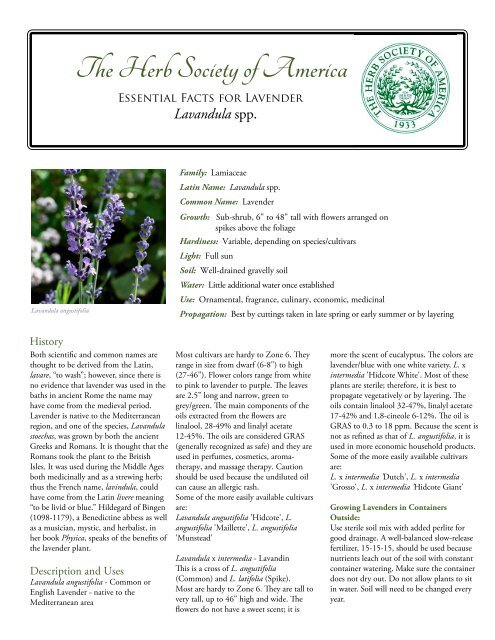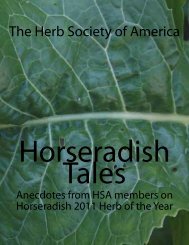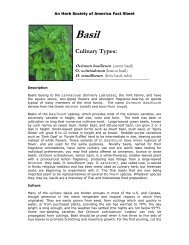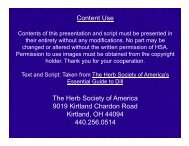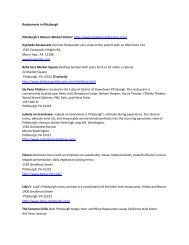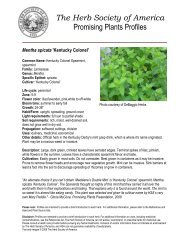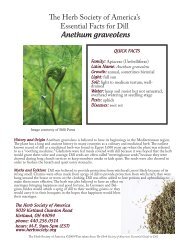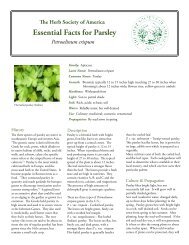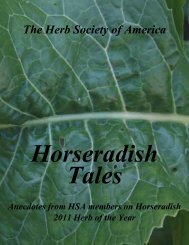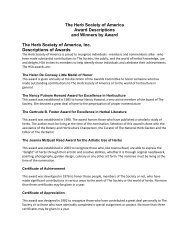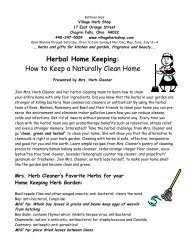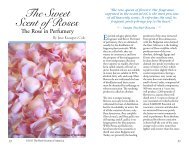lavender fact sheet 1 - The Herb Society of America
lavender fact sheet 1 - The Herb Society of America
lavender fact sheet 1 - The Herb Society of America
Create successful ePaper yourself
Turn your PDF publications into a flip-book with our unique Google optimized e-Paper software.
<strong>The</strong> <strong>Herb</strong> <strong>Society</strong> <strong>of</strong> <strong>America</strong><br />
Essential Facts for Lavender<br />
Lavandula spp.<br />
Lavandula angustifolia<br />
Family: Lamiaceae<br />
Latin Name: Lavandula spp.<br />
Common Name: Lavender<br />
Growth: Sub-shrub, 6" to 48" tall with flowers arranged on<br />
spikes above the foliage<br />
Hardiness: Variable, depending on species/cultivars<br />
Light: Full sun<br />
Soil: Well-drained gravelly soil<br />
Water: Little additional water once established<br />
Use: Ornamental, fragrance, culinary, economic, medicinal<br />
Propagation: Best by cuttings taken in late spring or early summer or by layering<br />
History<br />
Both scientific and common names are<br />
thought to be derived from the Latin,<br />
lavare, “to wash”; however, since there is<br />
no evidence that <strong>lavender</strong> was used in the<br />
baths in ancient Rome the name may<br />
have come from the medieval period.<br />
Lavender is native to the Mediterranean<br />
region, and one <strong>of</strong> the species, Lavandula<br />
stoechas, was grown by both the ancient<br />
Greeks and Romans. It is thought that the<br />
Romans took the plant to the British<br />
Isles. It was used during the Middle Ages<br />
both medicinally and as a strewing herb;<br />
thus the French name, lavindula, could<br />
have come from the Latin livere meaning<br />
“to be livid or blue.” Hildegard <strong>of</strong> Bingen<br />
(1098-1179), a Benedictine abbess as well<br />
as a musician, mystic, and herbalist, in<br />
her book Physica, speaks <strong>of</strong> the benefits <strong>of</strong><br />
the <strong>lavender</strong> plant.<br />
Description and Uses<br />
Lavandula angustifolia - Common or<br />
English Lavender - native to the<br />
Mediterranean area<br />
Most cultivars are hardy to Zone 6. <strong>The</strong>y<br />
range in size from dwarf (6-8") to high<br />
(27-46"). Flower colors range from white<br />
to pink to <strong>lavender</strong> to purple. <strong>The</strong> leaves<br />
are 2.5” long and narrow, green to<br />
grey/green. <strong>The</strong> main components <strong>of</strong> the<br />
oils extracted from the flowers are<br />
linalool, 28-49% and linalyl acetate<br />
12-45%. <strong>The</strong> oils are considered GRAS<br />
(generally recognized as safe) and they are<br />
used in perfumes, cosmetics, aromatherapy,<br />
and massage therapy. Caution<br />
should be used because the undiluted oil<br />
can cause an allergic rash.<br />
Some <strong>of</strong> the more easily available cultivars<br />
are:<br />
Lavandula angustifolia 'Hidcote', L.<br />
angustifolia 'Maillette', L. angustifolia<br />
'Munstead'<br />
Lavandula x intermedia - Lavandin<br />
This is a cross <strong>of</strong> L. angustifolia<br />
(Common) and L. latifolia (Spike).<br />
Most are hardy to Zone 6. <strong>The</strong>y are tall to<br />
very tall, up to 46" high and wide. <strong>The</strong><br />
flowers do not have a sweet scent; it is<br />
more the scent <strong>of</strong> eucalyptus. <strong>The</strong> colors are<br />
<strong>lavender</strong>/blue with one white variety, L. x<br />
intermedia 'Hidcote White'. Most <strong>of</strong> these<br />
plants are sterile; therefore, it is best to<br />
propagate vegetatively or by layering. <strong>The</strong><br />
oils contain linalool 32-47%, linalyl acetate<br />
17-42% and 1,8-cineole 6-12%. <strong>The</strong> oil is<br />
GRAS to 0.3 to 18 ppm. Because the scent is<br />
not as refined as that <strong>of</strong> L. angustifolia, it is<br />
used in more economic household products.<br />
Some <strong>of</strong> the more easily available cultivars<br />
are:<br />
L. x intermedia 'Dutch', L. x intermedia<br />
'Grosso', L. x intermedia 'Hidcote Giant'<br />
Growing Lavenders in Containers<br />
Outside:<br />
Use sterile soil mix with added perlite for<br />
good drainage. A well-balanced slow-release<br />
fertilizer, 15-15-15, should be used because<br />
nutrients leach out <strong>of</strong> the soil with constant<br />
container watering. Make sure the container<br />
does not dry out. Do not allow plants to sit<br />
in water. Soil will need to be changed every<br />
year.
L. x intermedias are less suitable than some <strong>of</strong> the others<br />
because <strong>of</strong> their size. Smaller L. angustifolias do well, as do<br />
the less hardy L. x ginginsii 'Goodwin Creek Grey' and L.<br />
buchii. L. stoechas, which is showing up in many garden<br />
centers, gets a very large root ball and may have to be<br />
repotted during the growing season.<br />
Growing Lavenders in Containers Inside:<br />
Same as above; place pot in a south facing window. Fertilize<br />
with a well-balanced fertilizer. <strong>The</strong> best to try inside are<br />
L. x ginginsii 'Goodwin Creek Grey', L. buchii and any<br />
L. dentata.<br />
Because the subject <strong>of</strong> <strong>lavender</strong>s is a very large and complex<br />
one, too vast to cover in a page or two, here are a few less<br />
hardy <strong>lavender</strong>s, some <strong>of</strong> which have been mentioned<br />
above, that are pleasant to grow.<br />
L. buchii - Zone 9-11 - native to the Canary Islands<br />
L. dentata - Zone 9 - native to eastern Spain and the<br />
Balearic Islands. A nice variegated cultivar to look for is<br />
'Linda Ligon'.<br />
L. x ginginsii 'Goodwin Creek Grey' - Zone 7 and up<br />
L. multifida - Zone 9 - native to the Mediterranean and<br />
southern Portugal<br />
L. latifolia - Zone 7b - native to the Mediterranean and<br />
Portugal<br />
L. stoechas - Zone 7b - native to the Mediterranean and<br />
Portugal. Two cultivars somewhat available are 'Otto Quast'<br />
and f. rosea 'Kew Red'.<br />
Culture & Propagation<br />
Soil:<br />
Well-drained gravelly soil; the natural environment is poor<br />
soil in dry, hilly areas. Lavenders are lovers <strong>of</strong> lime so it is<br />
suggested that when planting in the garden, a handful <strong>of</strong><br />
either crushed oyster shells or turkey grit should be placed<br />
in the bottom <strong>of</strong> the prepared hole. Place the plant in the<br />
hole, water it, fill with soil and then spread a generous<br />
handful <strong>of</strong> the oyster shells/turkey grit around the plant.<br />
Not only does this aid in drainage, it reflects both light and<br />
heat up into the plant. Be careful to space plants so that<br />
they have good air circulation. Avoid excess fertilizing.<br />
Older plants may like an application <strong>of</strong> bonemeal.<br />
Water:<br />
Once established, <strong>lavender</strong>s require little additional water<br />
but when watering either trickle water or use drip irrigation.<br />
Try not to water in the late afternoon. It is important<br />
that the foliage dry before nighttime, to avoid fungal<br />
infections.<br />
Propagation:<br />
Best by cuttings taken in late spring or early summer or<br />
layering, because many <strong>of</strong> the seeds do not come true. <strong>The</strong><br />
cuttings, with at least three or four nodes, should be dipped in rooting<br />
hormone and placed in a well draining sterile soil mix amended with<br />
perlite. <strong>The</strong> cuttings should not be covered because <strong>of</strong> the danger <strong>of</strong><br />
mildew and rot. Good air circulation is important both with cuttings<br />
and mature plants. Pinch new plants to encourage branching and remove<br />
any flowers on newly planted specimens.<br />
Pruning:<br />
Plants will grow better with annual pruning. In spring, do not prune<br />
until new growth is seen; at that time cut back by 1/3. Later new growth<br />
can be cut back 1/3 to stimulate new growth at the base <strong>of</strong> the plant. Do<br />
not prune out old wood unless completely dead. Prune after first bloom<br />
to stimulate a second bloom. Avoid heavy pruning after late August.<br />
Plants left unpruned for several years usually cannot be restored.<br />
Problems:<br />
If leaves look yellowish, plant will benefit from an application <strong>of</strong> a well<br />
balanced fertilizer, 15-15-15. If leaves turn yellow and then brown, the<br />
plant probably has root rot and there is no remedy; discard the plant.<br />
Aphids can be a problem; they can be removed with a strong spray <strong>of</strong><br />
water or by the application <strong>of</strong> insecticidal soap spray.<br />
Uses<br />
Medicinal:<br />
Historically <strong>lavender</strong> has been used to treat<br />
depression, insomnia, anxiety and fatigue.<br />
Research supports the calming, soothing<br />
and sedative effects <strong>of</strong> <strong>lavender</strong> when<br />
inhaled.<br />
Craft:<br />
While both the foliage and flowers are<br />
fragrant, typically flower buds are harvested<br />
and dried to scent potpourri, sleep pillows<br />
and other projects.<br />
Culinary:<br />
L. angustifolia flowers are preferred and used<br />
in teas, cookies and other confections as well as savory dishes. Lavender<br />
is a component <strong>of</strong> “<strong>Herb</strong>es de Provence” and Lady Grey Tea.<br />
L. stoechas ssp. pedunculata<br />
References<br />
Tucker, Arthur O., and Thomas DeBaggio. 2000. <strong>The</strong> Big Book <strong>of</strong><br />
<strong>Herb</strong>s: A Comprehensive Illustrated Reference to <strong>Herb</strong>s <strong>of</strong><br />
Flavor and Fragrance. Portland, OR: Timber Press.<br />
University <strong>of</strong> Maryland Medical Center. 2011. "Lavender." Last<br />
modified March 5, 2011.<br />
http://www.umm.edu/altmed/articles/<strong>lavender</strong>-000260.htm.<br />
Upson, Tim, and Susyn Andrews. 2004. <strong>The</strong> Genus Lavandula.<br />
Portland, OR: Timber Press.<br />
Medicinal Disclaimer - It is the policy <strong>of</strong> <strong>The</strong> <strong>Herb</strong> <strong>Society</strong> <strong>of</strong> <strong>America</strong> not to advise or recommend herbs for medicinal or health use. This information is intended for<br />
educational purposes only and should not be considered as a recommendation or an endorsement <strong>of</strong> any particular medical or health treatment.<br />
9019 Kirtland Chardon Rd. Kirtland, Ohio 44094 440.256.0514, herbs@herbsociety.org<br />
©2013 <strong>The</strong> <strong>Herb</strong> <strong>Society</strong> <strong>of</strong> <strong>America</strong> / Text by C. Amidon


